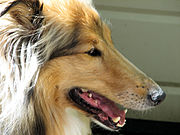Snout: Difference between revisions
Fama Clamosa (talk | contribs) m Reverted edits by 166.147.123.35 (talk) to last version by Grolltech |
|||
| Line 17: | Line 17: | ||
===Dogs=== |
===Dogs=== |
||
The muzzle begins at the [[wikt:stop|stop]], just below the eyes, and |
The muzzle begins at the [[wikt:stop|stop]], just below the eyes, and includes the dog's nose and mouth. In the domestic dog, most of the upper muzzle contains organs for detecting [[scent]]s. The loose flaps of skin on the sides of the upper muzzle that hang to different lengths over the [[mouth]] are called '''flews'''. The snout is considered a weak point on most animals: because of its structure, an animal can be easily stunned, snapped or even knocked out by applying sufficient force. |
||
It is innervated by one of the twelve pairs of cranial nerves. These nerves start in the brain and emerge through the skull to their target organs. Other destinations of these nerves are eyeballs, teeth and tongue. |
It is innervated by one of the twelve pairs of cranial nerves. These nerves start in the brain and emerge through the skull to their target organs. Other destinations of these nerves are eyeballs, teeth and tongue. |
||
Revision as of 11:34, 5 September 2013
This article needs attention from an expert in Animal. Please add a reason or a talk parameter to this template to explain the issue with the article. (December 2008) |


A snout is the protruding portion of an animal's face, consisting of its nose, mouth, and jaw. In many animals the equivalent structure is called a rostrum or a proboscis.
Terminology
The term "muzzle", used as a noun, can be ambiguous. It can refer both to the protruding part of the face itself, and also to a type of apparatus placed over the protruding part to prevent the animal from biting or eating, often used before and after horse races or to control dogs. See animal muzzle for the latter meaning.
The wet, naked surface around the nostrils of the nose is known as the rhinarium (colloquially this is the "cold wet nose" of some animals). The rhinarium is often associated with a stronger sense of olfaction.[citation needed]
Variation
This section needs expansion. You can help by adding to it. (December 2009) |

Snouts are found on many other mammals in a variety of shapes. Some animals, including ursines and great cats, have box-like snouts, while others, like shrews, have pointed snouts. Pig snouts are flat and cylindrical.
Dogs
The muzzle begins at the stop, just below the eyes, and includes the dog's nose and mouth. In the domestic dog, most of the upper muzzle contains organs for detecting scents. The loose flaps of skin on the sides of the upper muzzle that hang to different lengths over the mouth are called flews. The snout is considered a weak point on most animals: because of its structure, an animal can be easily stunned, snapped or even knocked out by applying sufficient force.
It is innervated by one of the twelve pairs of cranial nerves. These nerves start in the brain and emerge through the skull to their target organs. Other destinations of these nerves are eyeballs, teeth and tongue.
The muzzle shape of a domestic dog ranges in shape depending upon the breed, from extremely long and thin (dolichocephalic), as in the Rough Collie, to nearly nonexistent because it is so flat (extreme brachycephalic), as in the Pug. Some breeds, such as many sled dogs and Spitz types, have muzzles that somewhat resemble the original wolf's in size and shape, and others in the less extreme range have shortened it somewhat (mesocephalic) as in many hounds.
-
Dolichocephalic (long and thin snout): Rough Collie
-
Mesocephalic (medium length snout): English Cocker Spaniel
-
Brachycephalic (extremely flat snout): Pug
-
The flews of the Black and Tan Coonhound overhang the lower jaw.




